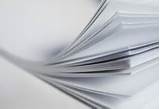 Looking after your printer or copier also means caring for the paper you feed into it. Preventing jams and damage to your office machine begins well before you hit the green button; it starts before you even load the paper into the input tray. Follow the tips here for the correct way to purchase, store and load your office paper and save yourself headache and hassle with your new office machine as well.
Looking after your printer or copier also means caring for the paper you feed into it. Preventing jams and damage to your office machine begins well before you hit the green button; it starts before you even load the paper into the input tray. Follow the tips here for the correct way to purchase, store and load your office paper and save yourself headache and hassle with your new office machine as well.
• The #1 biggest enemy to your paper is damp, humid or moist conditions. Make sure the packets arrive completely sealed, and they stay in this condition till as close as possible to time of use. Once the packet is opened ensure the humidity of the environment will not damage the paper. (If you live in a humid climate, leave paper in the tray for only a few hours at a time and store the paper in a sealed plastic bag when it’s not being used)
• Using quality paper will also enable a smoother and less problematic printing experience. High quality paper will have some grain to it, so that’s not completely smooth to the touch. This allows the copier or printer to hold onto the paper properly and send it through the machine without “losing its grip”. Generally, the heavier the paper weight, the more grain it will have. Use a minimum of 20lbs paper weight in any copier or inkjet printer and 24lbs. in a laser printer.
• Paper should be stored entirely flat and free from any risk of getting wrinkled, warped, or curled. Papers in such conditions are a recipe for causing paper jams in the machine.
• Paper straight out the packet might be slightly stuck to one another as a result of the pressure and compression during manufacture when cutting and stacking the sheaf. Make sure the stack of papers you load into the tray are not stuck by loosening the sheets by fanning them or roll the stack gently, diagonally, in opposite directions.
• Paper should be placed in the same room as the copy machine at least 24 hours before its use in the machine. This will allow the paper to acclimate to the temperature and humidity of the environment and will help it to perform better.
• Pull the tray completely out of the machine when loading the paper and make sure that any sliders are aligned properly to fit the size of the paper you are using. Don’t overload the tray with more papers than the specified capacity.
